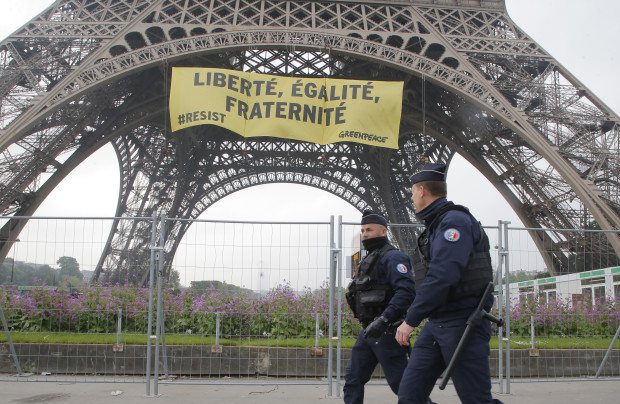Greenpeace: An ‘insane’ vision that took flight 50 years ago

Police officers walk past the Eiffel tower as Greenpeace activists display a banner who reads, ‘liberty, equality, fraternity” in Paris, France, Friday, May 5, 2017. AFP FILE PHOTO
PARIS — “Insane” — that was teenager Barbara Stowe’s reaction 50 years ago when her parents and the other founders of Greenpeace decided that they would send a boat to halt US nuclear tests.
But their conviction won over Stowe and her brother Robert, who witnessed these pathbreaking meetings in the family home in Vancouver to send a ship to Amchitka in Alaska.
“I have to say that my dad, my parents, the Bohlens, Bob Hunter, Ben Metcalfe, they were visionaries, they were empowered with the idea which is somewhat crazy that a single individual or a small group of individuals can actually effect change that can change the world,” said Robert Stowe, a 66-year-old neurologist.
“For them it was partly an issue of the fact they felt they had to take a stand, regardless of whether or not it would be effective.”
On September 15, 1971, a crew of 12 Canadians and Americans who had left their country after the Vietnam war, set out from Vancouver Island in an 80-foot boat called the Phyllis Cormack, which was renamed Greenpeace.
Article continues after this advertisementTheir mission was to steam to the Aleutian island of Amchitka and protest, or even prevent, the detonation of an underground nuclear test.
Article continues after this advertisementThe boat didn’t make it to Amchitka. US president Richard Nixon delayed the test and the crew were arrested in the Aleutian port of Akutan by the US Coastguard on a technicality.
At this time Greenpeace — now one of the best known names worldwide — was called Don’t Make a Wave but a name change was decided at a meeting to flesh out the daring and unprecedented mission to Alaska.
‘A green peace’
“Bill Darnell was leaving the meeting and my dad flashed the peace sign, and Bill said ‘make it a green peace’,” Robert Stowe said.
“Barbara and I were arguing with him at the breakfast table saying ‘Come on dad, Greenpeace is no word’. He said ‘No I think that’s it’.
“That’s how the name was formed. Initially it was two words, but when we had the buttons (badges) printed, the space between the two words was taken out.”
Barbara Stowe, a 65-year-old writer, said her first reaction to the Alaska mission was “This is insane.
“And then I saw it could be done,” she said.
“My father said we’ll have a rock concert and again I thought it was insane. But when he got Joni Mitchell and raised 17,000 (Canadian) dollars (to rent the boat), I had to start seeing that the impossible could be done and it was really exciting seeing the energy rise.”
‘Pacifism is a discipline’
The boat was intercepted by the US Coastguard and the mission foiled but the media coverage and the “mindbomb” paid off for Greenpeace, which has now added global warming to its long list of campaign battles.
Robert Stowe said the Quaker principles and unshakeable faith that helped shape the movement had paid rich dividends.
“If you have deep conviction that something is wrong and needs to be stopped or changed, and speak from the heart, people will listen to you,” he said.
“We have maintained our activism over the years although perhaps not as intensely as when we were teenagers,” Stowe admitted.
“I’m really moved by the action of Greenpeace activists in countries like China or Russia, where they risk long jail sentences.”
Barbara Stowe underscored the institution’s underlying commitment to non-violence.
“Pacifism is a discipline, difficult to apply when you’re young but the minute you use violence it’s going to come back against you,” she said.
When the French secret service “bombed the Rainbow Warrior to the bottom of the Auckland harbour and killed the photographer Fernando Pereira, that gave Greenpeace the biggest boost it ever had, its popularity rose enormously,” she said, of the infamous July 10, 1985 operation against the Greenpeace vessel.